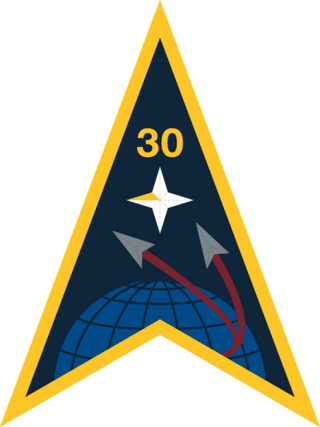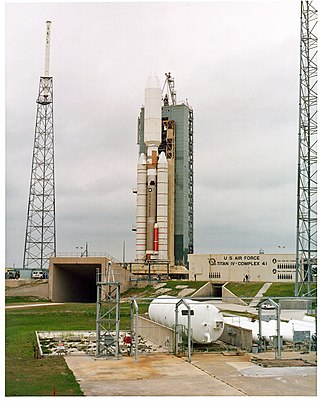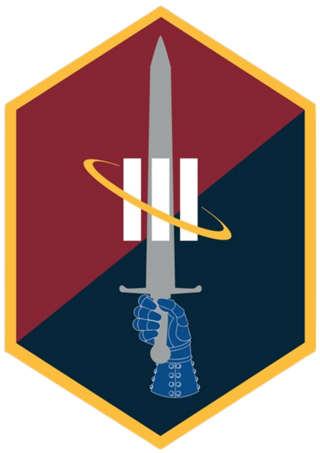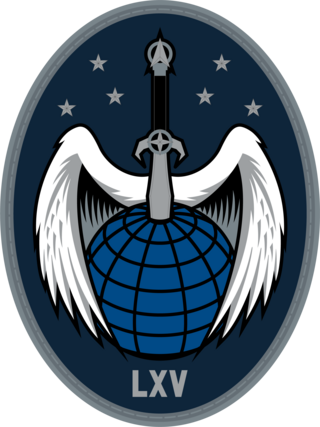
The 50th Wing is an inactive United States Air Force wing.

The 69th Cyberspace Squadron is a squadron of the United States Space Force located at Schriever Space Force Base, Colorado. It is responsible for conducting defensive cyberspace operations enabling operations in support of Space Delta 9's orbital warfare mission at Schriever Space Force Base, Colorado, and Space Delta 6's Satellite Control Network at various locations around the world. The 50th Communications Squadron was redesignated as the 69 Cyberspace Squadron on 15 Oct 2022.

Space Systems Command (SSC) is the United States Space Force's space development, acquisition, launch, and logistics field command. It is headquartered at Los Angeles Air Force Base, California, and manages the United States' space launch ranges.

Space Launch Delta 30 is a United States Space Force space launch delta assigned to Space Systems Command and headquartered at Vandenberg Space Force Base, California. The Space Launch Delta 30 is responsible for all space launch operations from the west coast, which includes all polar launches. It manages the Western Range and launch activities for the Space Force, Department of Defense, NASA, and other private space corporations. The Space Launch Delta 30 also supports test and evaluation launches of the U.S. Air Force's intercontinental ballistic missile force.

The Space Launch Delta 45 is a unit of the United States Space Force. The Space Launch Delta 45 is assigned to Space Systems Command and headquartered at Patrick Space Force Base, Florida. The wing also controls Cape Canaveral Space Force Station. The 45th Space Delta is responsible for all space launch operations from the East Coast. It manages the Eastern Range, including launch activities for the Space Force, Department of Defense (DoD), NASA, and other private space corporations.

The 2nd Space Launch Squadron is an active United States Space Force unit. It is located at Vandenberg Space Force Base, California, and was reactivated in July 2019 with the merger of the 4th Space Launch Squadron and the 1st Air and Space Test Squadron.

Space Base Delta 3 is a United States Space Force unit assigned to the Space Systems Command. The unit is stationed at Los Angeles Air Force Base in El Segundo, California, United States.

The 30th Operations Group was a group of the United States Space Force. It was assigned to the 30th Space Wing, stationed at Vandenberg Air Force Base, California. It was responsible for all space launch operations from the West Coast of the United States, including all polar launches. It operated the Western Range, which conducts launches for the Space Force, other parts of the Department of Defense, NASA, and private space corporations. In 2021 the 30th Operations Group and the 30th Mission Support Group were inactivated and squadrons assigned to Space Launch Delta 30.

Space Operations Command (SpOC) is the United States Space Force's space operations, cyber operations, and intelligence field command. Headquartered at Peterson Space Force Base, Colorado, it consists of its mission deltas, and garrison commands.

Space Training and Readiness Command is the United States Space Force's education, training, doctrine, and test field command. It is headquartered at Peterson Space Force Base, Colorado.

Space Delta 3 is a United States Space Force unit responsible for presenting operational combat-ready space electromagnetic warfare forces in support of assigned missions. It is headquartered at Peterson Space Force Base.

Space Base Delta 2 is a unit in the United States Space Force. It is assigned to Space Operations Command and headquartered at Buckley Space Force Base in Aurora, Colorado, United States.

The United States Space Force is organized by different units: the Space Staff, the field commands, and the space deltas.

Space Delta 6 is a United States Space Force unit which assures access to space through the $6.8 billion Satellite Control Network and defensive cyberspace capabilities for space mission systems.

Space Delta 1 is a United States Space Force unit responsible for space training. It runs the Space Force's basic military training, weapons school, and other advanced training courses and exercises. It was established on 23 August 2021 following the establishment of the Space Training and Readiness Command, the field command to which it reports. It is headquartered at Vandenberg Space Force Base, California.

Space Delta 12 is a United States Space Force unit responsible for space test and evaluation. It tests space systems and capabilities in support of weapon system acquisition, operational acceptance, and readiness. It was established on 23 August 2021 following the establishment of the Space Training and Readiness Command, the field command to which it reports. It is temporarily headquartered at Schriever Space Force Base, Colorado, but its final location requires a base selection process.

The 460th Operations Support Squadron was a United States Space Force unit. Assigned to Space Operations Command's Space Delta 4, it provided operational training and certification of all space professional assigned to the delta. It was headquartered at Buckley Space Force Base, Colorado.

The 65th Cyberspace Squadron is a United States Space Force unit responsible for defending the computer systems and networks used by Space Delta 5 and the Combined Space Operations Center against adversary actions in cyberspace. It was previously the 614th Air and Space Communications Squadron.

The 64th Cyberspace Squadron is a United States Space Force unit responsible for conducting defensive cyberspace operations enabling operations in support of Space Delta 4's missile warning mission at Buckley Space Force Base, Colorado. It was formed by redesignating the 62nd Cyberspace Squadron to the 64 CYS on 6 January 2023.

























